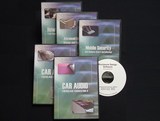Adding Aftermarket Head Units to Problem Vehicles
For as long as there have been aftermarket head units the vehicle manufacturers have tried to keep them out. The manufacturers want to sell you their high priced audio systems and not have you buy aftermarket equipment. One of the ways they have done this is by making the head unit non-standard.
Odd Shapes
One of the most common ways to make a radio non-standard is to make it a different shape. The common aftermarket shape is the DIN chassis (50mm x 180mm or 7" x 2"). Vehicle manufacturers will then make their head units 1.5 DIN, Double DIN, non-rectangular or a limited depth. Usually this can be overcome by using a dash kit that will fill in the gaps. The drawbacks are the blank space and possibility of the new head unit sticking out more than the factory unit.
The aftermarket has created their own odd sized radios to overcome some of these issues. For example, Pioneer used to make a couple of units that would exactly fit many GM and Chrysler 1.5 DIN vehicles. There are also many manufacturers that make double DIN units.
You can also have a custom bracket made to fit your new radio. And if depth is an issue the dash cavity may be able to be changed to accommodate the extra depth. For example, the AC/heat ducting can be re-worked for extra space. This will of course be more expensive than a mass manufactured kit.
Integrated Components
Another trick the vehicle manufacturers use is to integrate other non-audio features into the head unit. Most commonly this is climate control and security features. Removing the factory head unit will cause more problems then just a blank space here. You'll also lose control of these features.
In some cases the factory radio can be relocated to another area of the vehicle (like the trunk) so that these functions can be retained. This will not work for climate controls of course because you'll want them within arms reach. And as time goes on other aftermarket adapter manufacturers will usually come out with a unit that can plug into the vehicle to replicate these features. The factory radio can then be removed entirely.
As always, you can seek out a professional that is highly capable and willing to customize your installation if an aftermarket solution is not available. Keep in mind that you'll need to find a specialized installer that can handle this type of work. It may also void certain parts of your vehicle's warranty if the manufacturer can prove that the modification caused a problem.
Where to Go for Help
You'll be able to find many dash kits available from companies such as Metra and Scosche. There are others available but these are the top two in my book.
Specialty adapters are available from companies such as Precision Interface Electronics (PIE), Pacific Accessory Corporation (PAC), Blitzsafe and others.
If nothing is available for your vehicle in the aftermarket then you'll probably have to seek out a professional installer. There aren't a lot of installers that can manipulate the electronics but plenty that can fabricate custom dash kits. Be prepared to travel if you can't find the right installer in your area. Also, search online and see what others have done with your vehicle (no sense in re-inventing the wheel).
Bottom line: Anything is possible with the right installer and the right amount of money. Money is also what drives the aftermarket to create the adapters you'll need to add that new head unit to your non-standard factory system. If there's a way, they'll find it.

The Car Audio Help DVD catalog includes five different videos covering many areas of car audio installation and custom fabrication. Topics range from basic system installation (head units, amplifiers, speakers, etc.) and mobile security (car alarms and remote start) to subwoofer box design and fiberglass fabrication. If you're interested in custom fabrication and car audio installation be sure to check out what we have to offer.
Click here to see the discount DVD packages
Back to the Newsletter Archives Index